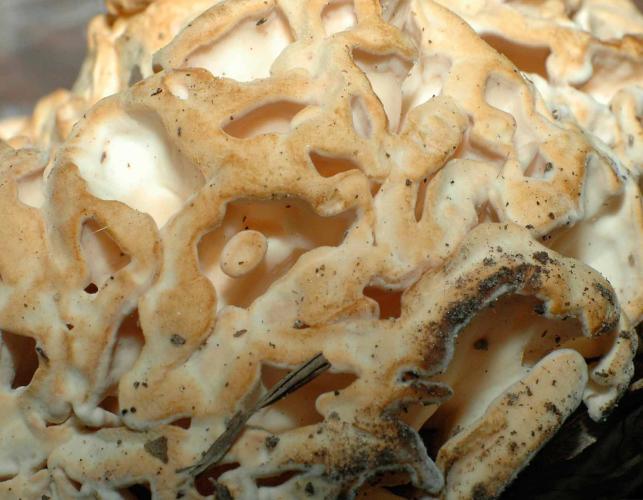
Large, stalkless, whitish yellow rosette; flattened, wavy, ribbonlike folds. Grows singly, at the bases of trees and often at the base of decayed oak stumps. July–October. Fruiting body a large rosette with flattened, wavy, ribbonlike folds; whitish yellow; texture smooth; has a cordlike root at the base; flesh is flexible when young, becoming tough with age. Spore print white. Spores magnified are oval, smooth, colorless.
Lookalikes: Hen of the woods (Grifola frondosa) has many small, grayish to brownish caps. Black-staining polypore (Meripilus sumstinei) blackens when bruised or handled. Berkeley’s polypore (Bondarzewia berkeleyi) is thick-fleshed and cream-colored. The closely related wood cauliflower mushroom (S. crispa) is rare and differs in some of its branching characteristics; it is a choice edible.
Fruiting body width: 6–12 inches; height: 6–10 inches.

Statewide.
Habitat and Conservation
Grows singly, at the bases of trees and often at the base of decayed oak stumps. It can be quite common when we have a good, wet summer. However, it is rare in a dry summer. It can reappear in the same spot annually. It is unusual-looking and easy to identify. Think of a wavy, whitish yellow ribbon.
Status
Considered an excellent edible—when young and fresh. If you should find this mushroom, you’re in luck. You could possibly have several meals off of it! The genus name, Sparassis, is derived from Greek and means “I tear to pieces.” If you have more than you can eat, cook and freeze to store, as drying will make it tough.
Life Cycle
This species lives as a network of cells (mycelium) within living trees as a parasite, and dead trees as a saprobe, digesting and decomposing the wood. When ready to reproduce, the mycelium develops the mushroom cluster that emerges from near the base of the tree — it is a reproductive structure. Spores are produced in pores on the undersides of the caps and are released to begin new mycelia elsewhere.
Human Connections
Humans have eaten mushrooms for thousands of years, in many cultures, for various purposes. Sometimes they are eaten for their nutritional and culinary value; sometimes they are considered medicinal. Even the ones that can't be eaten can be appreciated for their forms and colors.
Ecosystem Connections
Fungi are vitally important for a healthy ecosystem. This fungus feeds off of dead or dying trees, decomposing them as they go. This cleans the forest and helps nutrients to cycle back into the soil — an unglamorous but vital role in the ecosystem.




Mushrooms are a lot like plants, but they lack chlorophyll and have to take nutrients from other materials. Mushrooms are neither plants nor animals. They are in a different kingdom — the fungi. Fungi include the familiar mushroom-forming species, plus the yeasts, molds, smuts, and rusts.
Always be cautious when eating edible mushrooms. Be absolutely sure of the ID, and only eat a small amount the first time you try it to avoid a reaction..





















